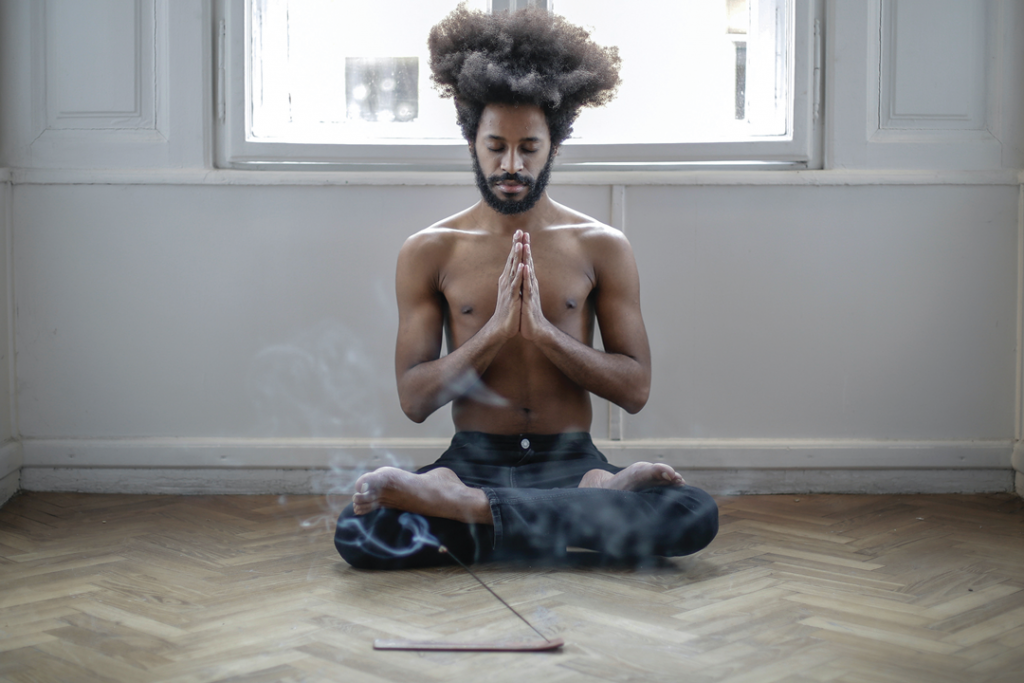By Jayita Bhattacharjee
Mantra Meditation (OM Meditation)…. A mantra is a syllable or word that is repeated in order to have your mind focused. It should not be thought of as an affirmation that convinces yourself of something. There is a vibration associated with the sound and meaning which makes an initiation into it a necessity. Mantras are used in Hindu traditions, Buddhist traditions, Sikhism, Jainism, and Taoism. Some people call Mantra meditation… ”OM Meditation”. A more devoted practice of Mantras is called “Japa” and consists of the repetition of sacred sounds with love. IT is usually practiced with the spine in an erect posture, and closed eyes. The practitioner then keeps on repeating the Mantra in his mind, silently over and over again. Sometimes the breathing is coordinated with it. The Mantra is whispered softly and lightly as an aid to concentration. The mantra repetition produces a mental vibration that takes the mind into profound levels of awareness. As you meditate further and further, the mantra gradually becomes so theoretical and blurred, until you finally land into the field of pure awareness from which the vibration emerged.
The repetition of the mantra creates a disconnection from the thoughts that invade our minds, so you fall into space between your thoughts. The mantra can be viewed as a tool that assists in meditative practice. They can be seen as the words packed with the power of the ancient times which have very refined intentions that assist us as we are on a journey to find our lost connection to the spirit which is the source, the fount of everything in the universe.
What are Mantras? Mantra is a Sanskrit word which is derived from two roots: man (“man” mind or to think) and trai (means to protect or to free from, or instrument/tool). So, mantras are looked upon as tools of the mind or tools to free the mind. Mantras derive their value mostly from their sound quality. Some of them are short, one-syllable mantras others are long and composed of many words. IT allows the mind to become calm and centered and works just like focusing on your breath or any other meditation object. Secondly, a mantra can be viewed as a tool for transforming consciousness. The idea is that every sound, every vibration has a certain quality to it, and can create different states of mind and consciousness when they are repeated for a long period of time.
There is a transformative power of sound. Sound is vibration and all the cells in your body are vibrating. Everything in the universe is vibrating and each has its own rhythm. Your thoughts and feelings are indeed vibrations in your body and your consciousness. Sound patterns have an impact on the water in the body, and the hormones secretion, behavior, cognition, and psychological well- being. From this perspective, your mind and psyche become a collection of patterns with each vibrating at its own frequency, speed and volume. The discovery of yogic of yore is that by sustaining a particular sound vibration for a long time, the mind and body can be truly transformed. It can also change your emotional state, e.g. overcoming pain and anxiety, uplifting your moods. And you can gradually access a deeper state of consciousness, and the mind can be well controlled so you can go into samadhi (a state of transcendent union, the highest state of meditation). Sound has the power to induce and evoke moods, thoughts, and emotions and hence emerges the power of programming
a specific sound into your mind, by a thousand repetitions.
Thus, Mantra Meditation purifies, pacifies and transforms the mind and heart. Thus, Mantra as a toll and instrument of the mind can create profound changes in the body and psyche and produce transformed states of consciousness. It is the method of rotation of consciousness around a particular sound, which is amplified for a maximum effect. Many people find it easier to focus on a mantra than with the breathing. Its usefulness comes when the mind is racing with many thoughts, as its mantra meditation demands continual attention.
With the inclusion of mantra, it gets easier to integrate your meditative state into your daily life. Mantra replaces thinking. Paying full attention to the mantra leaves no room for disturbance by any other thoughts, memories or sensations. Being able to string the ending of one mantra repetition to the beginning of next helps us to remain in that beautiful state for the duration of that meditation. A mantra replaces thousand different thoughts by one thought which offers peace and awareness and allows you to gather your scattered attention that is spread all over the place. With the recitation of mantra, you unify it and thus you ultimately empower yourself. It overrides the constant mental warbling which is the predominant form of conscious thinking for the majority. The faster repetition of mantra creates gamma waves in the brain. The slow repetition of it creates theta waves.
Yoga Meditation… Several types of meditation are taught in the yogic type. Yoga means union and its goal is spiritual purification and self-knowledge.
Classical yoga divides it into rules of conduct (yamas and niyamas), physical postures (asanas), breathing exercises (pranayama), contemplative practices followed in meditation( pratyahara, dharana, Dhyana, samadhi). Till to date, the yoga tradition is most ancient meditation tradition on earth and the one that has the widest variety of practices. The most universal Yoga Meditation is the Third Eye meditation. Others involve focusing on a chakra, repeating a mantra, visualization of light, or gazing meditation. Third Eye Meditation… The attention focuses on the sacred spot located between the eyebrows. It is redirected to this point to silence the mind. With time, the “silent gaps” between thoughts get wider and deeper. The third eye is also called the Ajna Chakra.
Chakra Meditation: In this practice, the focus is on one of the seven chakras of the body. Chakras denote the centers of energy. The focus is placed on them by some visualization and by chanting a special mantra for each chakra which are (lam, vam, ram, yam, ham, om).
Typically, it is done on the heart chakra, third eye, and crown chakra.
Gazing Meditation: (Trataka) You fix your gaze on an external object which can be a candle, image or a symbol (yantra). It is performed with eyes open and then with eyes closed to master the concentration and visualization powers of the mind. After the eyes are closed, one needs to have the image of the object in the mind’s eye.
Kundalini Meditation: It focuses on the awakening of the kundalini energy that lies dormant on the base of the spine. This meditation also focuses on the development of several psychic centers in the body and ultimately awareness and enlightenment.
Kriya Yoga: It is a collective group of energization, breathing and meditation exercises taught by the father of Yoga, Paramahansa Yogananda.
Sound meditation: It focuses on sound. It begins with a meditation on external sounds such as ambient music which is very soothing for the spirit where the attention is mainly on hearing to still and collect the mind. With time, you evolve to hear the internal sounds of body and mind and finally, you hear the ultimate sound which is a sound without vibration which manifests as OM.
Tantra: Bring a union between the mind and the senses in the interior space in the spiritual heart. With the perception of one object, all the other objects are perceived as empty and then you can focus on that emptiness. Focus on the space which exists between two thoughts. Then fixate your attention which is inside the skull and close your eyes. Meditate on any delightful feeling. Follow this with the meditation on a feeling of pain. Be in the reality which exists between pain and pleasure. Meditate on the void inside one’s body that gradually extends in all directions. Concentrate on a well that has no bottom, or as standing in a very high place. Then pay attention to the Anahata or heart chakra sound. Then give your ears to a musical instrument as it slowly dies away. Contemplate on the universe or one’s own body as it is filled with bliss. Focus on the fact that the universe is completely void. Contemplate that the same consciousness exists in all the bodies.
Pranayama: It is breathing regulation. It is a practice to still the mind and to prepare it for meditation. The simplest form of Pranayama is 4-4-4-4. It denotes breathing in counting up to 4, holding for 4 seconds, breathing out for 4 seconds, and holding empty for 4 seconds. You breathe through your nose and let your abdomen be the one that moves but not the chest. You go through some cycles like this. This breathing regulation balances the moods and calms down the body and it can be done anywhere.
A mantra in Yoga: In the tradition of Yoga, mantra repetition is connected with the breathing, visualizations, contemplations and chakras. Chakras: In
certain lineages, there is the practice of mantra recitation keeping the mind focused on specific chakras. Repeat the seed-sound of each chakra. Root Chakra (LAM) “lum”, Sacral Chakra (VAM) “vum”, Solar Plexus chakra (RAM)”rum”, Heart Chakra, (YAM) “yum”, Throat Chakra (HAM)”hum”, Third Eye Chakra (OM), Crown Chakra (silence). It is called Chakra Mantra Dharana.
Pranayama Breathing: In some Yogic schools, there is also the practice of synchronizing the mantra with specific breathing patterns. E.g. A-HAM mantra…I AM… Repeating A upon inhalation and HAM upon exhalation. SO-HAM mantra: Repeating “SO” upon inhalation and “HAM” upon exhalation, while moving your attention and breathing up and down your spine.
SOHAM-HAMSA: Inhale through the left nostril as you repeat “so”, then exhale through your right nostril as you repeat “ham”. On your way back, now do the following: Inhale through your right nostril repeating…..”ham” and exhale through your left nostril repeating “sa”. That is one entire cycle. Practice a minimum of ten cycles. Some of the most well- known mantras from the Hindu as well as the Buddhist traditions: Om, so-ham, om namah shivaya, om mani padme hum, rama, yam, hum. With the furthering of the practice, you may see that the mantra keeps continuing by itself, much like the humming of the mind. But a time comes when the mantra may even disappear, and you are left in tranquil serenity.
A mantra in Bhakti Yoga: In the Yoga of devotion, the mantra that is used is the name of the divine in the form and aspect you prefer.
Transcendental Meditation: It is a specific form of Mantra Meditation which was introduced by Maharishi Mahesh Yogi in India and the West. It involves the use of a mantra and is practiced for 15-20 minutes twice per day while being seated with the eyes closed. The mantra is given to the practitioner based on age and gender. They are not meaningless sounds, but they are Tantric names of Hindu deities.
Self-Inquiry and ” I am” Meditation…. It finds to find the answer to the “Who am I?” It very much culminates with the intimate knowledge of our true self, our true being. Your sense of I or ego is the core of your universe. In some form or other, it is there behind all your thoughts, emotions, memory and perceptions. Yet we are unclear about what this…”I” is, about who we truly are in essence, and we get into confusion with our body and mind. It’s a shrouded mystery in our lives. With self-inquiry, the question” Who am I” is inquired within yourself. You engage in this questioning simply as an instrument to fixate your focus on the subjective feeling of ”I” or “ I am”. You become one with it as you go deeper and deeper into it. It then gives you a revelation of your true ”I”, your authentic self as pure consciousness, limitless and boundless. This is not an intellectual pursuit, but an inquiry to guide the attention to the central element of your perception and experience: the ”I”. This is a pure subjective feeling of existing without any images or concepts attached to it. Whenever thoughts and feelings arise, you inquire yourself: “To whom does this arise?” or “Who is aware of fear, pain, anger or any other feelings?” the answer will be” It is me”. And then you begin to inquire” Who am I?” to guide the attention back to the subjective feeling of self, of presence. It is a pure existence that is free from any object or choice, objectless and choiceless. You focus your mind on your feeling of being, the non-verbal” I am” which is radiant within you. It has no association with anything you perceive. With all the other types of meditation, the” I”(yourself) is focusing on some object, internal or external, physical or mental. In self-inquiry meditation, the “I” is focusing on itself, the subject. It becomes the attention turned towards its source.







